EDU 20001 : Developing Literacy
VerifiedAdded on 2021/09/30
|10
|2277
|130
AI Summary
Contribute Materials
Your contribution can guide someone’s learning journey. Share your
documents today.
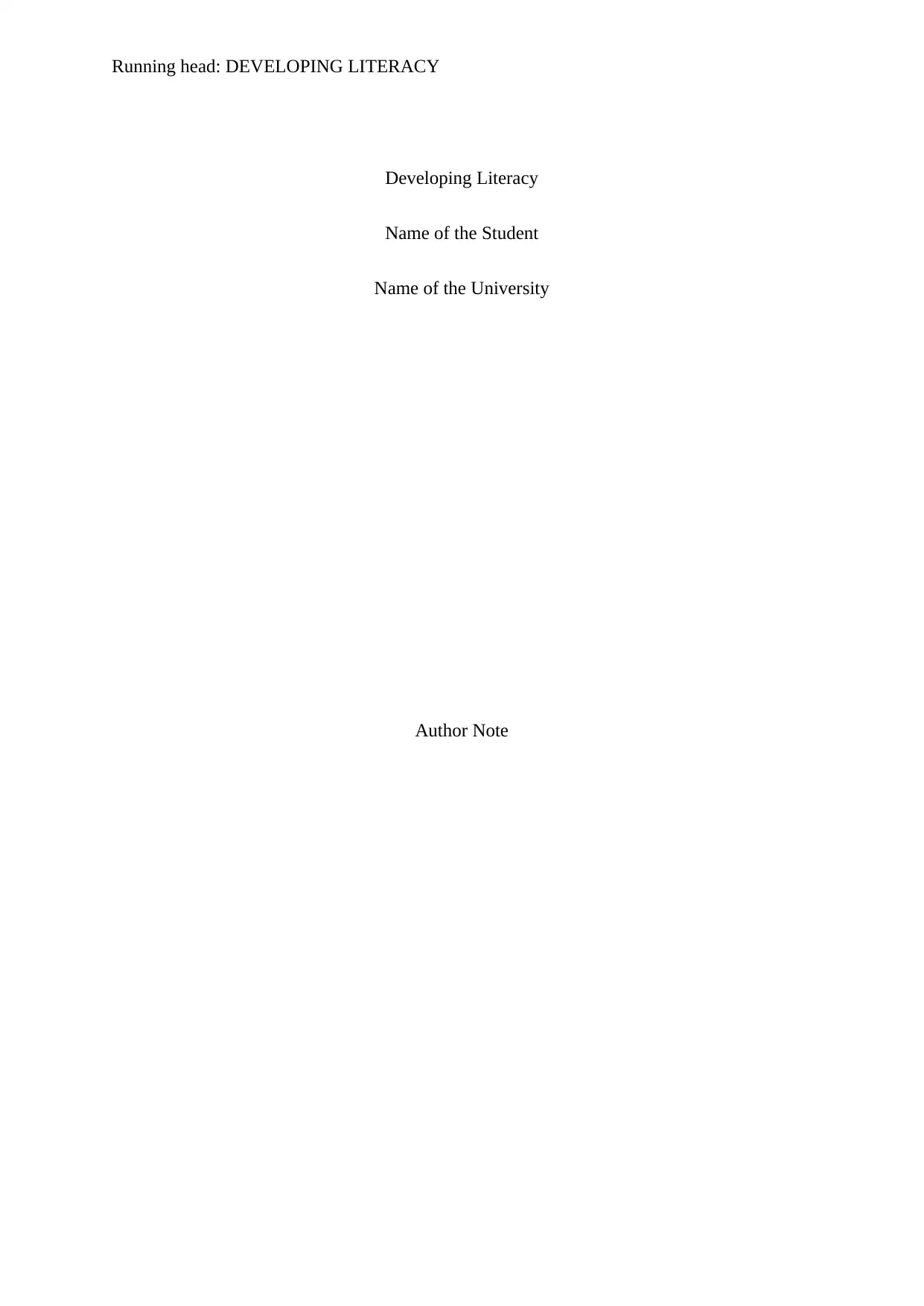
Running head: DEVELOPING LITERACY
Developing Literacy
Name of the Student
Name of the University
Author Note
Developing Literacy
Name of the Student
Name of the University
Author Note
Secure Best Marks with AI Grader
Need help grading? Try our AI Grader for instant feedback on your assignments.
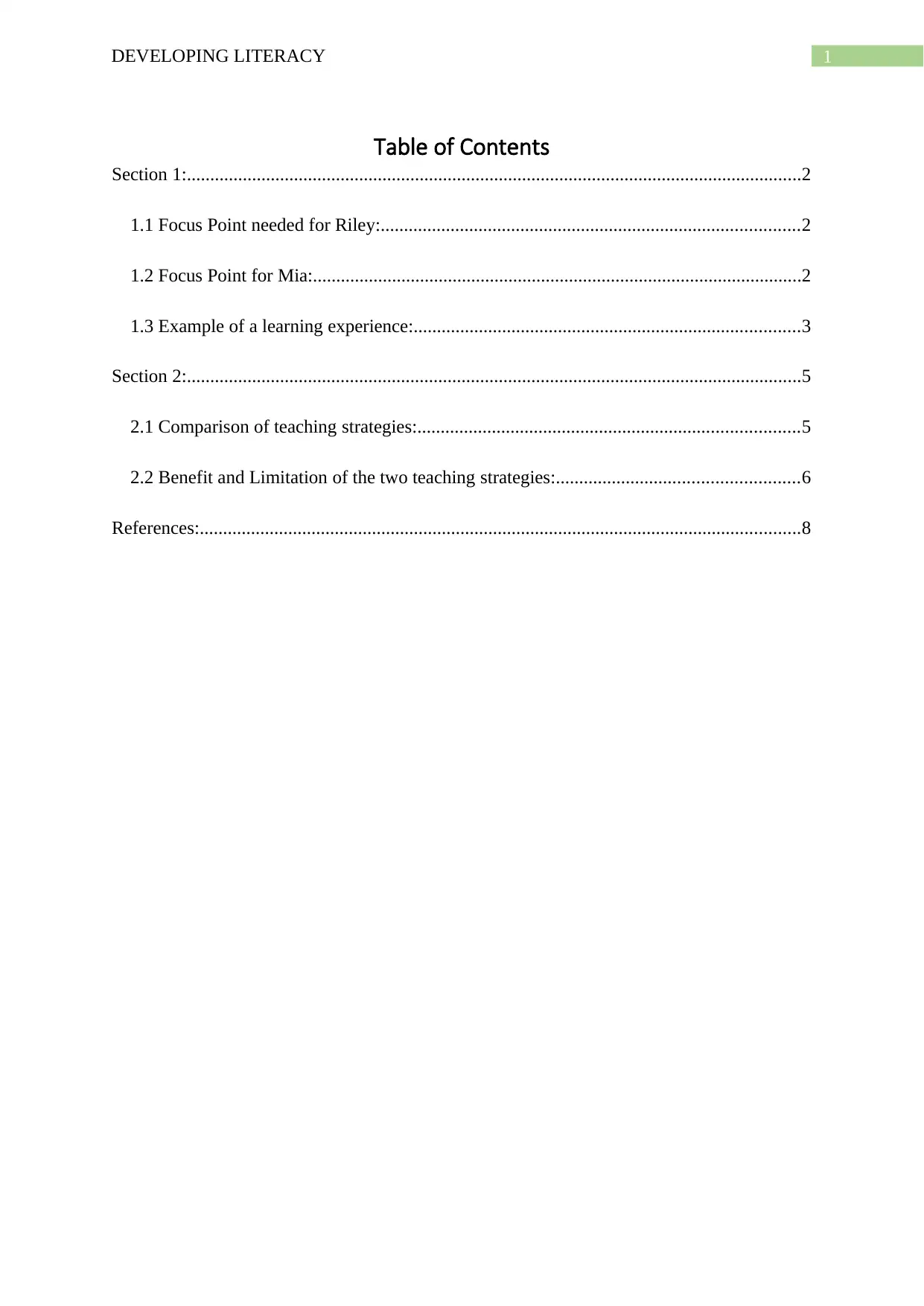
1DEVELOPING LITERACY
Table of Contents
Section 1:....................................................................................................................................2
1.1 Focus Point needed for Riley:..........................................................................................2
1.2 Focus Point for Mia:.........................................................................................................2
1.3 Example of a learning experience:...................................................................................3
Section 2:....................................................................................................................................5
2.1 Comparison of teaching strategies:..................................................................................5
2.2 Benefit and Limitation of the two teaching strategies:....................................................6
References:.................................................................................................................................8
Table of Contents
Section 1:....................................................................................................................................2
1.1 Focus Point needed for Riley:..........................................................................................2
1.2 Focus Point for Mia:.........................................................................................................2
1.3 Example of a learning experience:...................................................................................3
Section 2:....................................................................................................................................5
2.1 Comparison of teaching strategies:..................................................................................5
2.2 Benefit and Limitation of the two teaching strategies:....................................................6
References:.................................................................................................................................8
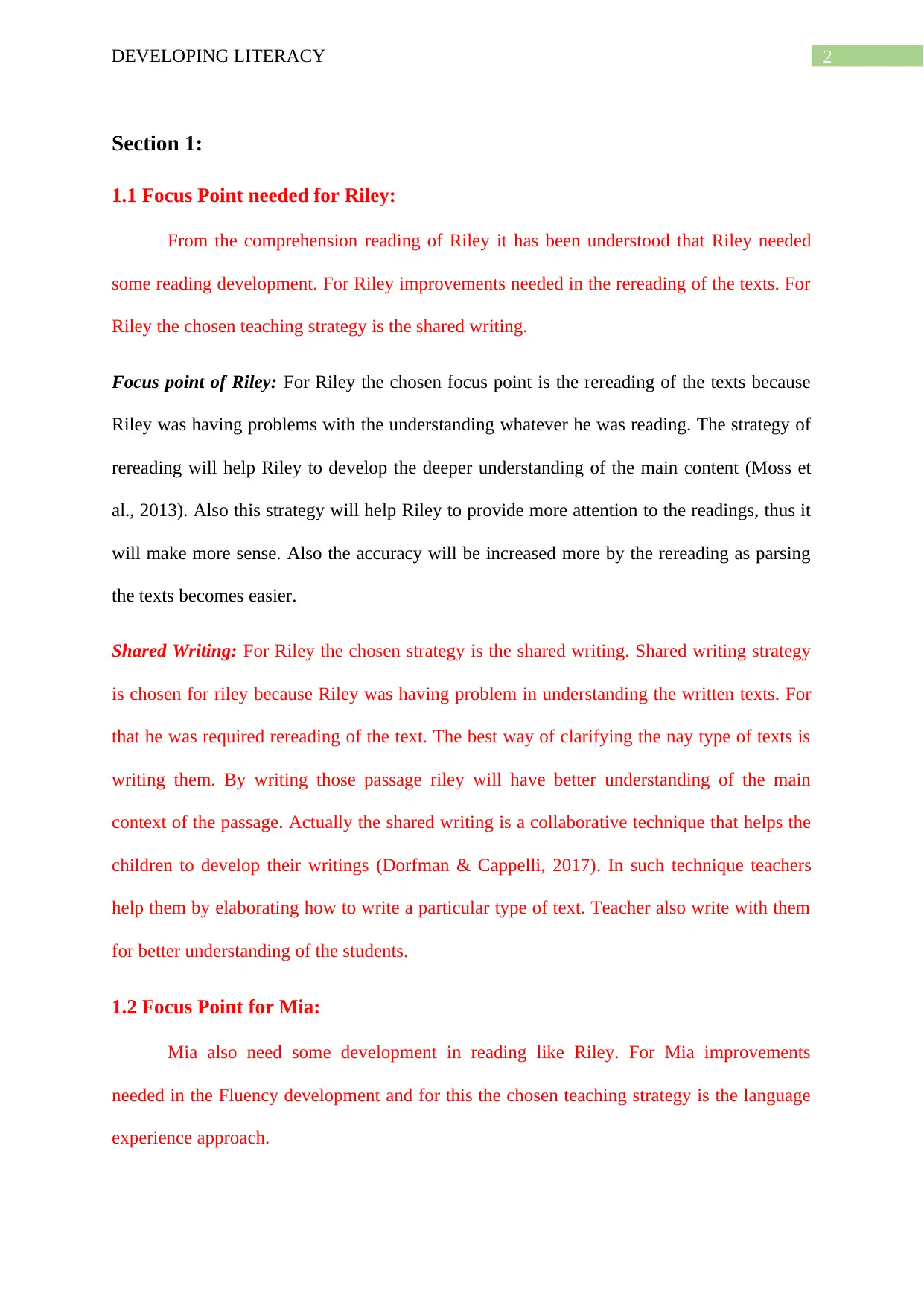
2DEVELOPING LITERACY
Section 1:
1.1 Focus Point needed for Riley:
From the comprehension reading of Riley it has been understood that Riley needed
some reading development. For Riley improvements needed in the rereading of the texts. For
Riley the chosen teaching strategy is the shared writing.
Focus point of Riley: For Riley the chosen focus point is the rereading of the texts because
Riley was having problems with the understanding whatever he was reading. The strategy of
rereading will help Riley to develop the deeper understanding of the main content (Moss et
al., 2013). Also this strategy will help Riley to provide more attention to the readings, thus it
will make more sense. Also the accuracy will be increased more by the rereading as parsing
the texts becomes easier.
Shared Writing: For Riley the chosen strategy is the shared writing. Shared writing strategy
is chosen for riley because Riley was having problem in understanding the written texts. For
that he was required rereading of the text. The best way of clarifying the nay type of texts is
writing them. By writing those passage riley will have better understanding of the main
context of the passage. Actually the shared writing is a collaborative technique that helps the
children to develop their writings (Dorfman & Cappelli, 2017). In such technique teachers
help them by elaborating how to write a particular type of text. Teacher also write with them
for better understanding of the students.
1.2 Focus Point for Mia:
Mia also need some development in reading like Riley. For Mia improvements
needed in the Fluency development and for this the chosen teaching strategy is the language
experience approach.
Section 1:
1.1 Focus Point needed for Riley:
From the comprehension reading of Riley it has been understood that Riley needed
some reading development. For Riley improvements needed in the rereading of the texts. For
Riley the chosen teaching strategy is the shared writing.
Focus point of Riley: For Riley the chosen focus point is the rereading of the texts because
Riley was having problems with the understanding whatever he was reading. The strategy of
rereading will help Riley to develop the deeper understanding of the main content (Moss et
al., 2013). Also this strategy will help Riley to provide more attention to the readings, thus it
will make more sense. Also the accuracy will be increased more by the rereading as parsing
the texts becomes easier.
Shared Writing: For Riley the chosen strategy is the shared writing. Shared writing strategy
is chosen for riley because Riley was having problem in understanding the written texts. For
that he was required rereading of the text. The best way of clarifying the nay type of texts is
writing them. By writing those passage riley will have better understanding of the main
context of the passage. Actually the shared writing is a collaborative technique that helps the
children to develop their writings (Dorfman & Cappelli, 2017). In such technique teachers
help them by elaborating how to write a particular type of text. Teacher also write with them
for better understanding of the students.
1.2 Focus Point for Mia:
Mia also need some development in reading like Riley. For Mia improvements
needed in the Fluency development and for this the chosen teaching strategy is the language
experience approach.
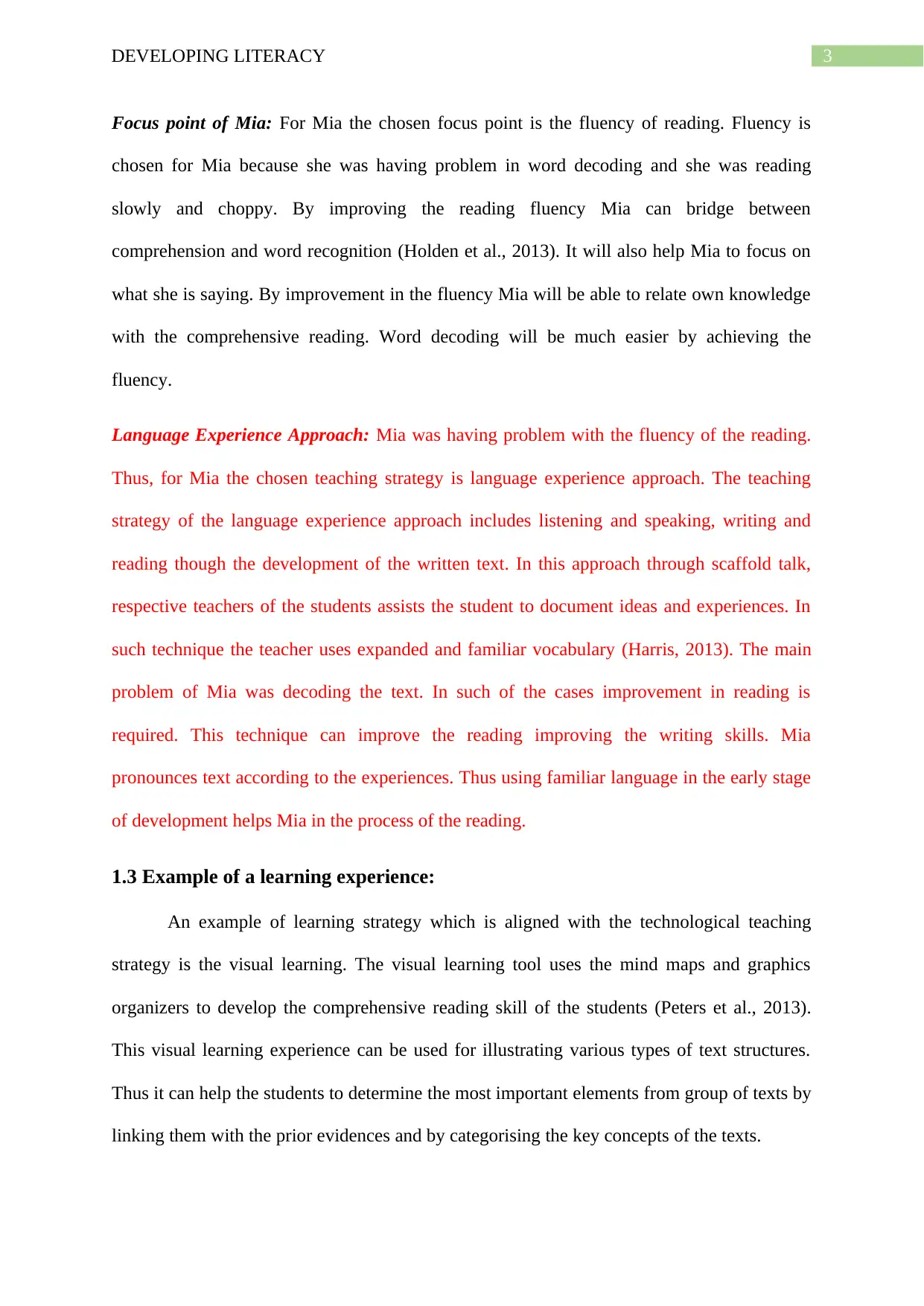
3DEVELOPING LITERACY
Focus point of Mia: For Mia the chosen focus point is the fluency of reading. Fluency is
chosen for Mia because she was having problem in word decoding and she was reading
slowly and choppy. By improving the reading fluency Mia can bridge between
comprehension and word recognition (Holden et al., 2013). It will also help Mia to focus on
what she is saying. By improvement in the fluency Mia will be able to relate own knowledge
with the comprehensive reading. Word decoding will be much easier by achieving the
fluency.
Language Experience Approach: Mia was having problem with the fluency of the reading.
Thus, for Mia the chosen teaching strategy is language experience approach. The teaching
strategy of the language experience approach includes listening and speaking, writing and
reading though the development of the written text. In this approach through scaffold talk,
respective teachers of the students assists the student to document ideas and experiences. In
such technique the teacher uses expanded and familiar vocabulary (Harris, 2013). The main
problem of Mia was decoding the text. In such of the cases improvement in reading is
required. This technique can improve the reading improving the writing skills. Mia
pronounces text according to the experiences. Thus using familiar language in the early stage
of development helps Mia in the process of the reading.
1.3 Example of a learning experience:
An example of learning strategy which is aligned with the technological teaching
strategy is the visual learning. The visual learning tool uses the mind maps and graphics
organizers to develop the comprehensive reading skill of the students (Peters et al., 2013).
This visual learning experience can be used for illustrating various types of text structures.
Thus it can help the students to determine the most important elements from group of texts by
linking them with the prior evidences and by categorising the key concepts of the texts.
Focus point of Mia: For Mia the chosen focus point is the fluency of reading. Fluency is
chosen for Mia because she was having problem in word decoding and she was reading
slowly and choppy. By improving the reading fluency Mia can bridge between
comprehension and word recognition (Holden et al., 2013). It will also help Mia to focus on
what she is saying. By improvement in the fluency Mia will be able to relate own knowledge
with the comprehensive reading. Word decoding will be much easier by achieving the
fluency.
Language Experience Approach: Mia was having problem with the fluency of the reading.
Thus, for Mia the chosen teaching strategy is language experience approach. The teaching
strategy of the language experience approach includes listening and speaking, writing and
reading though the development of the written text. In this approach through scaffold talk,
respective teachers of the students assists the student to document ideas and experiences. In
such technique the teacher uses expanded and familiar vocabulary (Harris, 2013). The main
problem of Mia was decoding the text. In such of the cases improvement in reading is
required. This technique can improve the reading improving the writing skills. Mia
pronounces text according to the experiences. Thus using familiar language in the early stage
of development helps Mia in the process of the reading.
1.3 Example of a learning experience:
An example of learning strategy which is aligned with the technological teaching
strategy is the visual learning. The visual learning tool uses the mind maps and graphics
organizers to develop the comprehensive reading skill of the students (Peters et al., 2013).
This visual learning experience can be used for illustrating various types of text structures.
Thus it can help the students to determine the most important elements from group of texts by
linking them with the prior evidences and by categorising the key concepts of the texts.
Secure Best Marks with AI Grader
Need help grading? Try our AI Grader for instant feedback on your assignments.
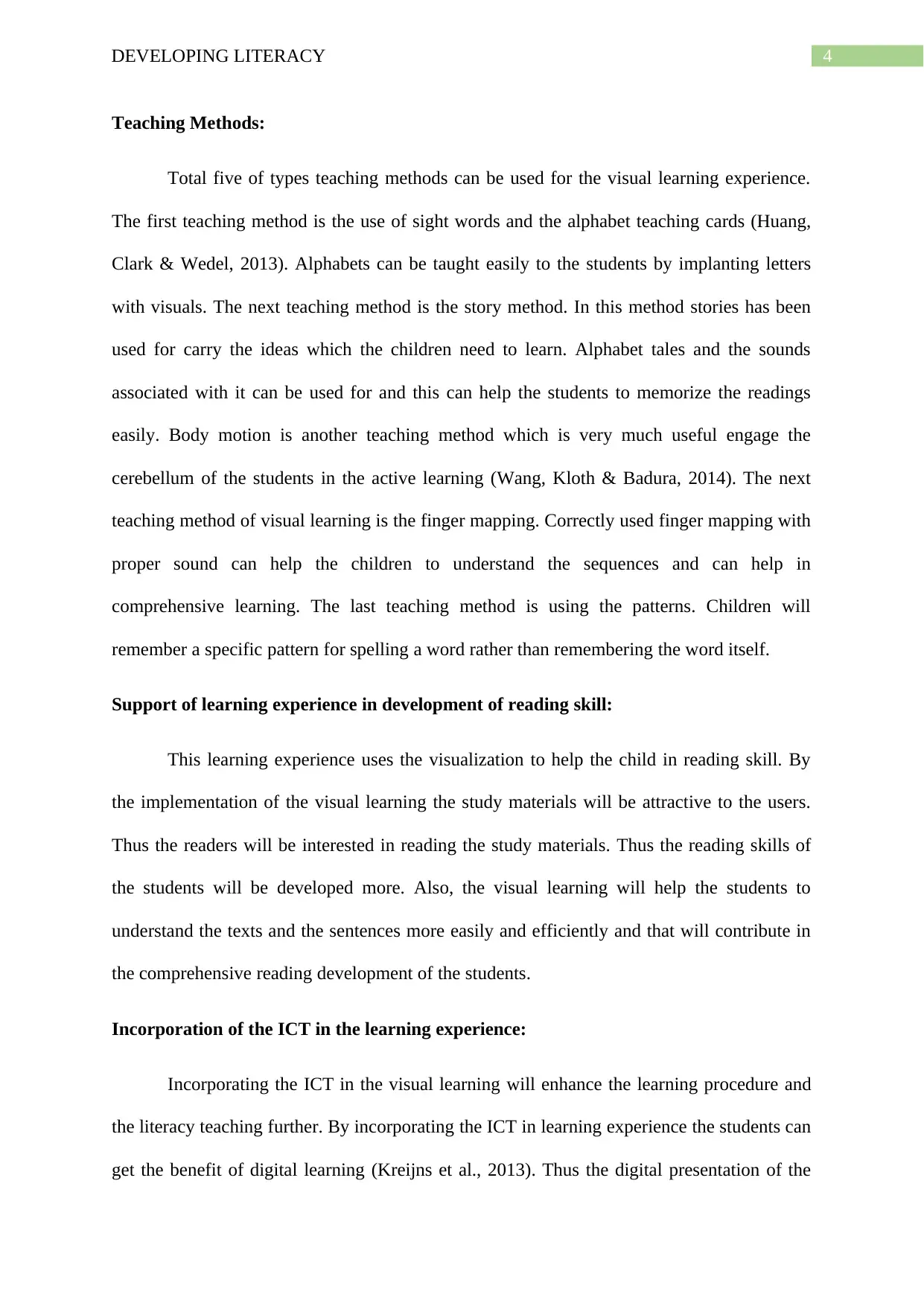
4DEVELOPING LITERACY
Teaching Methods:
Total five of types teaching methods can be used for the visual learning experience.
The first teaching method is the use of sight words and the alphabet teaching cards (Huang,
Clark & Wedel, 2013). Alphabets can be taught easily to the students by implanting letters
with visuals. The next teaching method is the story method. In this method stories has been
used for carry the ideas which the children need to learn. Alphabet tales and the sounds
associated with it can be used for and this can help the students to memorize the readings
easily. Body motion is another teaching method which is very much useful engage the
cerebellum of the students in the active learning (Wang, Kloth & Badura, 2014). The next
teaching method of visual learning is the finger mapping. Correctly used finger mapping with
proper sound can help the children to understand the sequences and can help in
comprehensive learning. The last teaching method is using the patterns. Children will
remember a specific pattern for spelling a word rather than remembering the word itself.
Support of learning experience in development of reading skill:
This learning experience uses the visualization to help the child in reading skill. By
the implementation of the visual learning the study materials will be attractive to the users.
Thus the readers will be interested in reading the study materials. Thus the reading skills of
the students will be developed more. Also, the visual learning will help the students to
understand the texts and the sentences more easily and efficiently and that will contribute in
the comprehensive reading development of the students.
Incorporation of the ICT in the learning experience:
Incorporating the ICT in the visual learning will enhance the learning procedure and
the literacy teaching further. By incorporating the ICT in learning experience the students can
get the benefit of digital learning (Kreijns et al., 2013). Thus the digital presentation of the
Teaching Methods:
Total five of types teaching methods can be used for the visual learning experience.
The first teaching method is the use of sight words and the alphabet teaching cards (Huang,
Clark & Wedel, 2013). Alphabets can be taught easily to the students by implanting letters
with visuals. The next teaching method is the story method. In this method stories has been
used for carry the ideas which the children need to learn. Alphabet tales and the sounds
associated with it can be used for and this can help the students to memorize the readings
easily. Body motion is another teaching method which is very much useful engage the
cerebellum of the students in the active learning (Wang, Kloth & Badura, 2014). The next
teaching method of visual learning is the finger mapping. Correctly used finger mapping with
proper sound can help the children to understand the sequences and can help in
comprehensive learning. The last teaching method is using the patterns. Children will
remember a specific pattern for spelling a word rather than remembering the word itself.
Support of learning experience in development of reading skill:
This learning experience uses the visualization to help the child in reading skill. By
the implementation of the visual learning the study materials will be attractive to the users.
Thus the readers will be interested in reading the study materials. Thus the reading skills of
the students will be developed more. Also, the visual learning will help the students to
understand the texts and the sentences more easily and efficiently and that will contribute in
the comprehensive reading development of the students.
Incorporation of the ICT in the learning experience:
Incorporating the ICT in the visual learning will enhance the learning procedure and
the literacy teaching further. By incorporating the ICT in learning experience the students can
get the benefit of digital learning (Kreijns et al., 2013). Thus the digital presentation of the
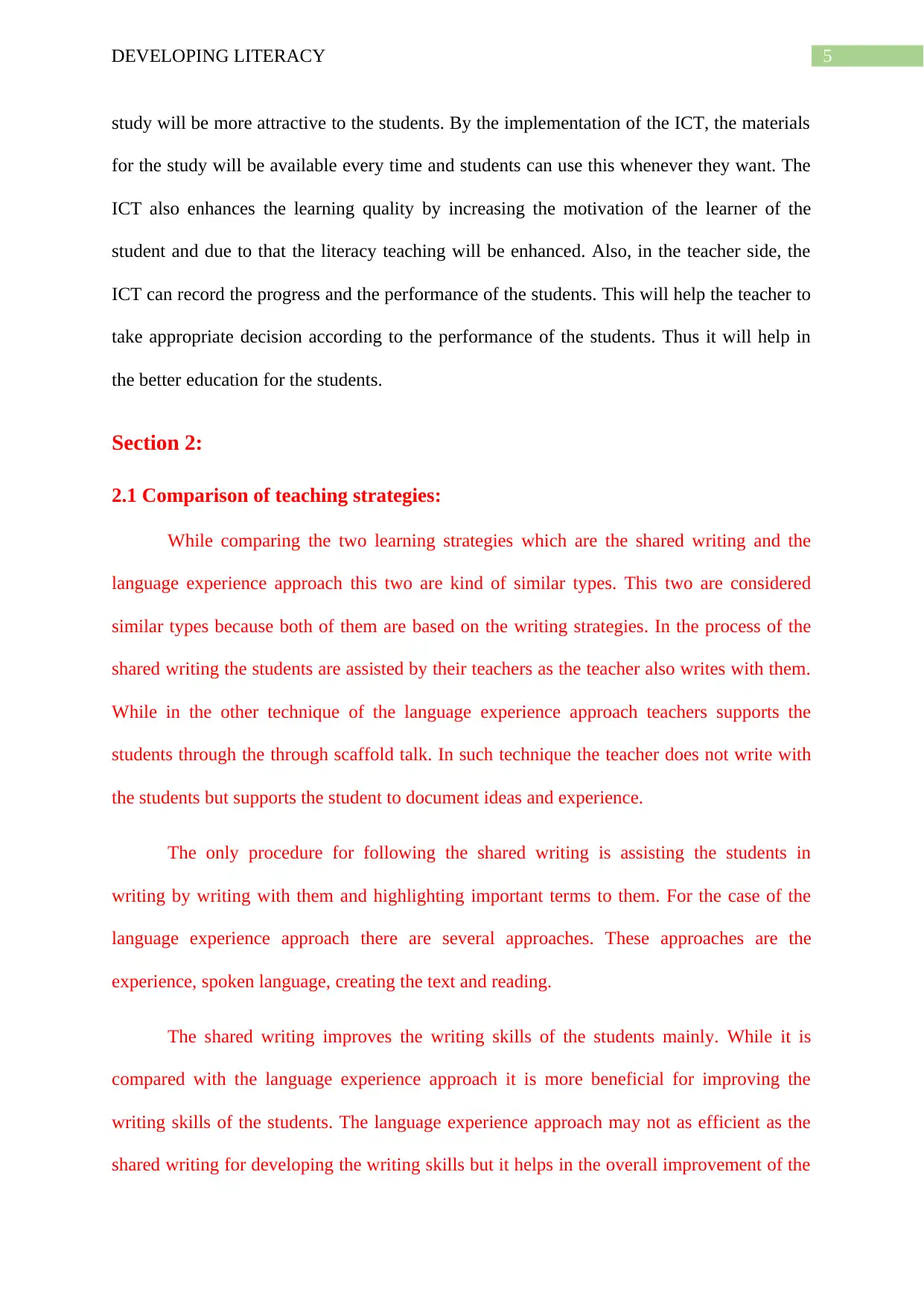
5DEVELOPING LITERACY
study will be more attractive to the students. By the implementation of the ICT, the materials
for the study will be available every time and students can use this whenever they want. The
ICT also enhances the learning quality by increasing the motivation of the learner of the
student and due to that the literacy teaching will be enhanced. Also, in the teacher side, the
ICT can record the progress and the performance of the students. This will help the teacher to
take appropriate decision according to the performance of the students. Thus it will help in
the better education for the students.
Section 2:
2.1 Comparison of teaching strategies:
While comparing the two learning strategies which are the shared writing and the
language experience approach this two are kind of similar types. This two are considered
similar types because both of them are based on the writing strategies. In the process of the
shared writing the students are assisted by their teachers as the teacher also writes with them.
While in the other technique of the language experience approach teachers supports the
students through the through scaffold talk. In such technique the teacher does not write with
the students but supports the student to document ideas and experience.
The only procedure for following the shared writing is assisting the students in
writing by writing with them and highlighting important terms to them. For the case of the
language experience approach there are several approaches. These approaches are the
experience, spoken language, creating the text and reading.
The shared writing improves the writing skills of the students mainly. While it is
compared with the language experience approach it is more beneficial for improving the
writing skills of the students. The language experience approach may not as efficient as the
shared writing for developing the writing skills but it helps in the overall improvement of the
study will be more attractive to the students. By the implementation of the ICT, the materials
for the study will be available every time and students can use this whenever they want. The
ICT also enhances the learning quality by increasing the motivation of the learner of the
student and due to that the literacy teaching will be enhanced. Also, in the teacher side, the
ICT can record the progress and the performance of the students. This will help the teacher to
take appropriate decision according to the performance of the students. Thus it will help in
the better education for the students.
Section 2:
2.1 Comparison of teaching strategies:
While comparing the two learning strategies which are the shared writing and the
language experience approach this two are kind of similar types. This two are considered
similar types because both of them are based on the writing strategies. In the process of the
shared writing the students are assisted by their teachers as the teacher also writes with them.
While in the other technique of the language experience approach teachers supports the
students through the through scaffold talk. In such technique the teacher does not write with
the students but supports the student to document ideas and experience.
The only procedure for following the shared writing is assisting the students in
writing by writing with them and highlighting important terms to them. For the case of the
language experience approach there are several approaches. These approaches are the
experience, spoken language, creating the text and reading.
The shared writing improves the writing skills of the students mainly. While it is
compared with the language experience approach it is more beneficial for improving the
writing skills of the students. The language experience approach may not as efficient as the
shared writing for developing the writing skills but it helps in the overall improvement of the
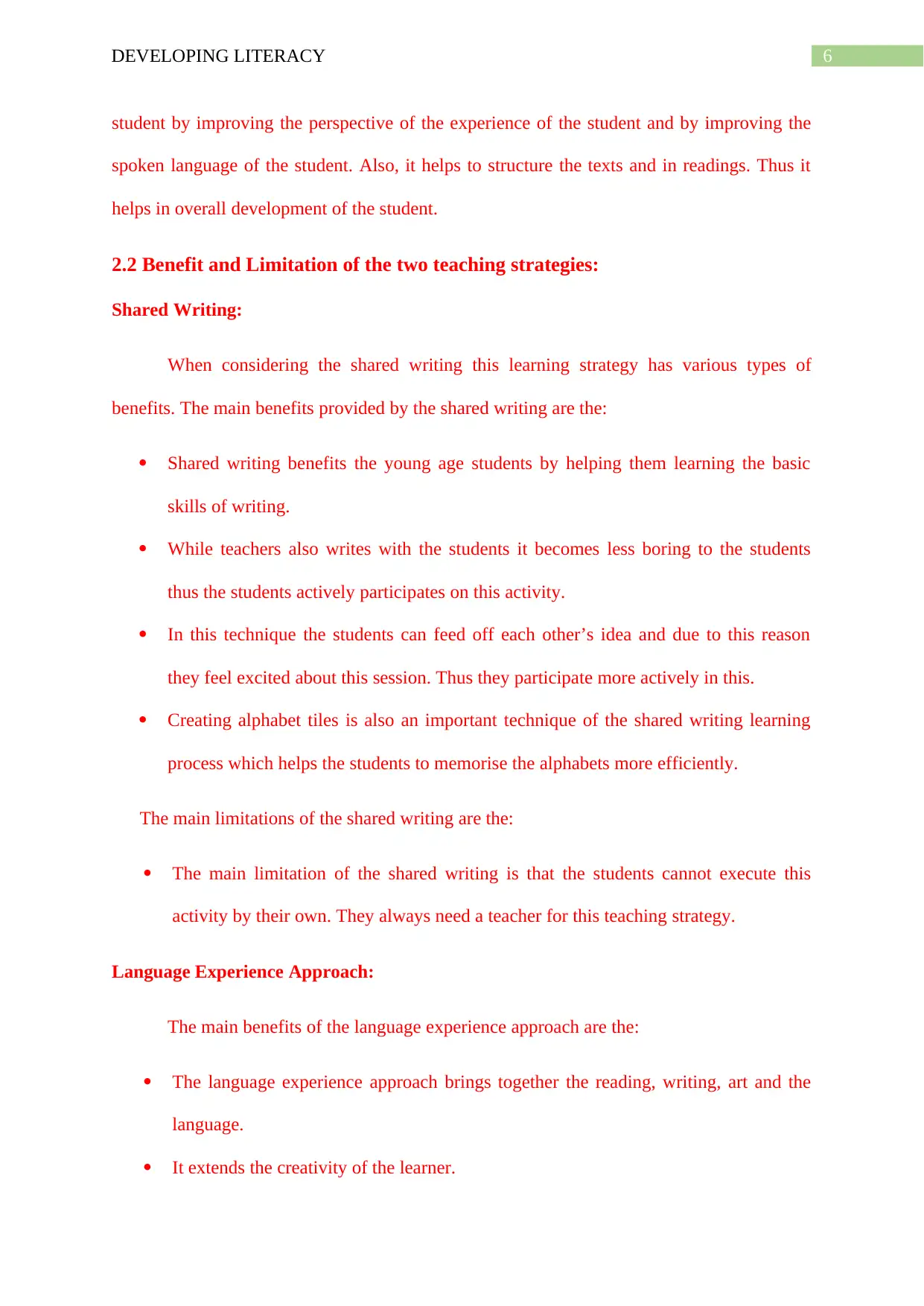
6DEVELOPING LITERACY
student by improving the perspective of the experience of the student and by improving the
spoken language of the student. Also, it helps to structure the texts and in readings. Thus it
helps in overall development of the student.
2.2 Benefit and Limitation of the two teaching strategies:
Shared Writing:
When considering the shared writing this learning strategy has various types of
benefits. The main benefits provided by the shared writing are the:
Shared writing benefits the young age students by helping them learning the basic
skills of writing.
While teachers also writes with the students it becomes less boring to the students
thus the students actively participates on this activity.
In this technique the students can feed off each other’s idea and due to this reason
they feel excited about this session. Thus they participate more actively in this.
Creating alphabet tiles is also an important technique of the shared writing learning
process which helps the students to memorise the alphabets more efficiently.
The main limitations of the shared writing are the:
The main limitation of the shared writing is that the students cannot execute this
activity by their own. They always need a teacher for this teaching strategy.
Language Experience Approach:
The main benefits of the language experience approach are the:
The language experience approach brings together the reading, writing, art and the
language.
It extends the creativity of the learner.
student by improving the perspective of the experience of the student and by improving the
spoken language of the student. Also, it helps to structure the texts and in readings. Thus it
helps in overall development of the student.
2.2 Benefit and Limitation of the two teaching strategies:
Shared Writing:
When considering the shared writing this learning strategy has various types of
benefits. The main benefits provided by the shared writing are the:
Shared writing benefits the young age students by helping them learning the basic
skills of writing.
While teachers also writes with the students it becomes less boring to the students
thus the students actively participates on this activity.
In this technique the students can feed off each other’s idea and due to this reason
they feel excited about this session. Thus they participate more actively in this.
Creating alphabet tiles is also an important technique of the shared writing learning
process which helps the students to memorise the alphabets more efficiently.
The main limitations of the shared writing are the:
The main limitation of the shared writing is that the students cannot execute this
activity by their own. They always need a teacher for this teaching strategy.
Language Experience Approach:
The main benefits of the language experience approach are the:
The language experience approach brings together the reading, writing, art and the
language.
It extends the creativity of the learner.
Paraphrase This Document
Need a fresh take? Get an instant paraphrase of this document with our AI Paraphraser
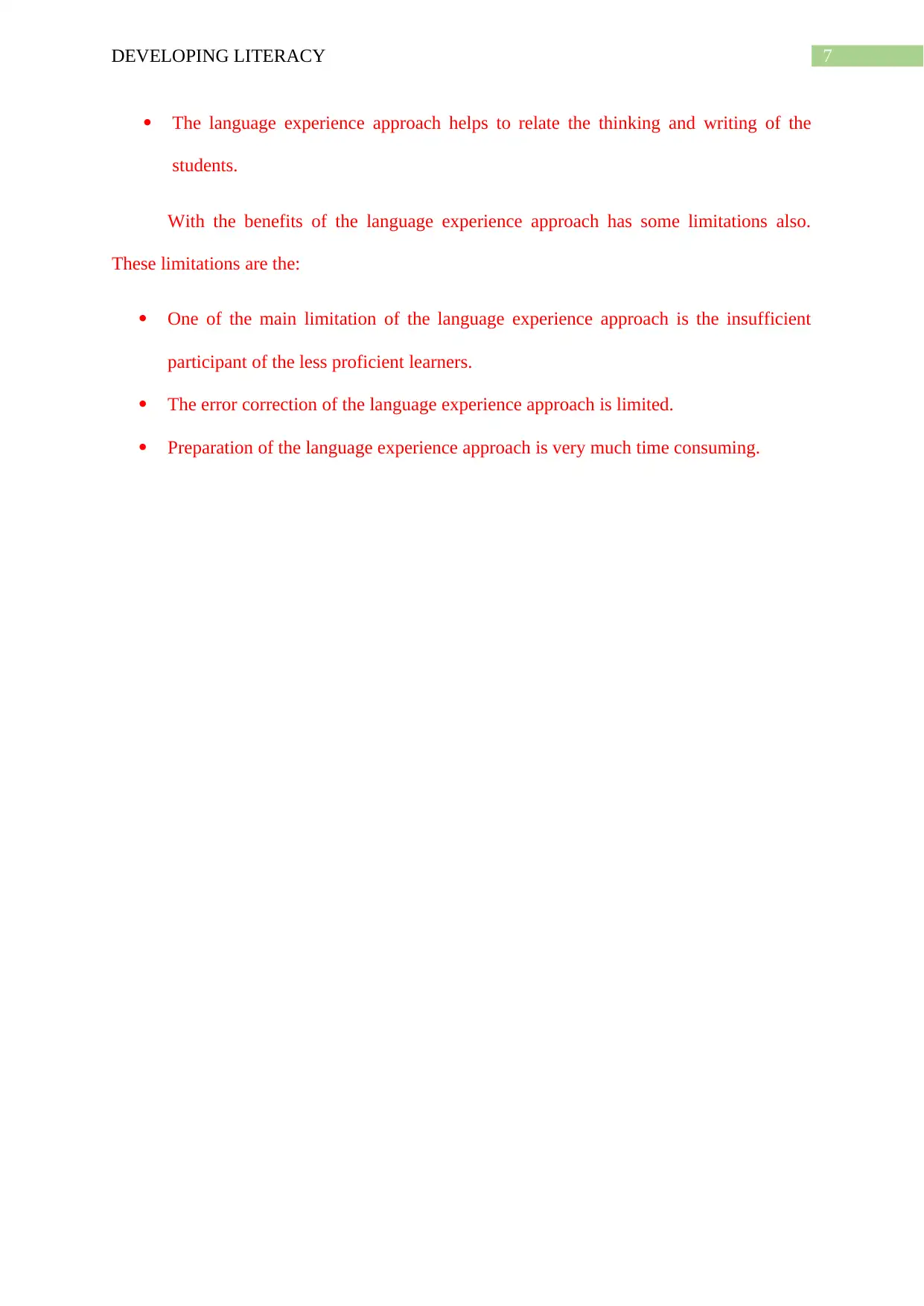
7DEVELOPING LITERACY
The language experience approach helps to relate the thinking and writing of the
students.
With the benefits of the language experience approach has some limitations also.
These limitations are the:
One of the main limitation of the language experience approach is the insufficient
participant of the less proficient learners.
The error correction of the language experience approach is limited.
Preparation of the language experience approach is very much time consuming.
The language experience approach helps to relate the thinking and writing of the
students.
With the benefits of the language experience approach has some limitations also.
These limitations are the:
One of the main limitation of the language experience approach is the insufficient
participant of the less proficient learners.
The error correction of the language experience approach is limited.
Preparation of the language experience approach is very much time consuming.
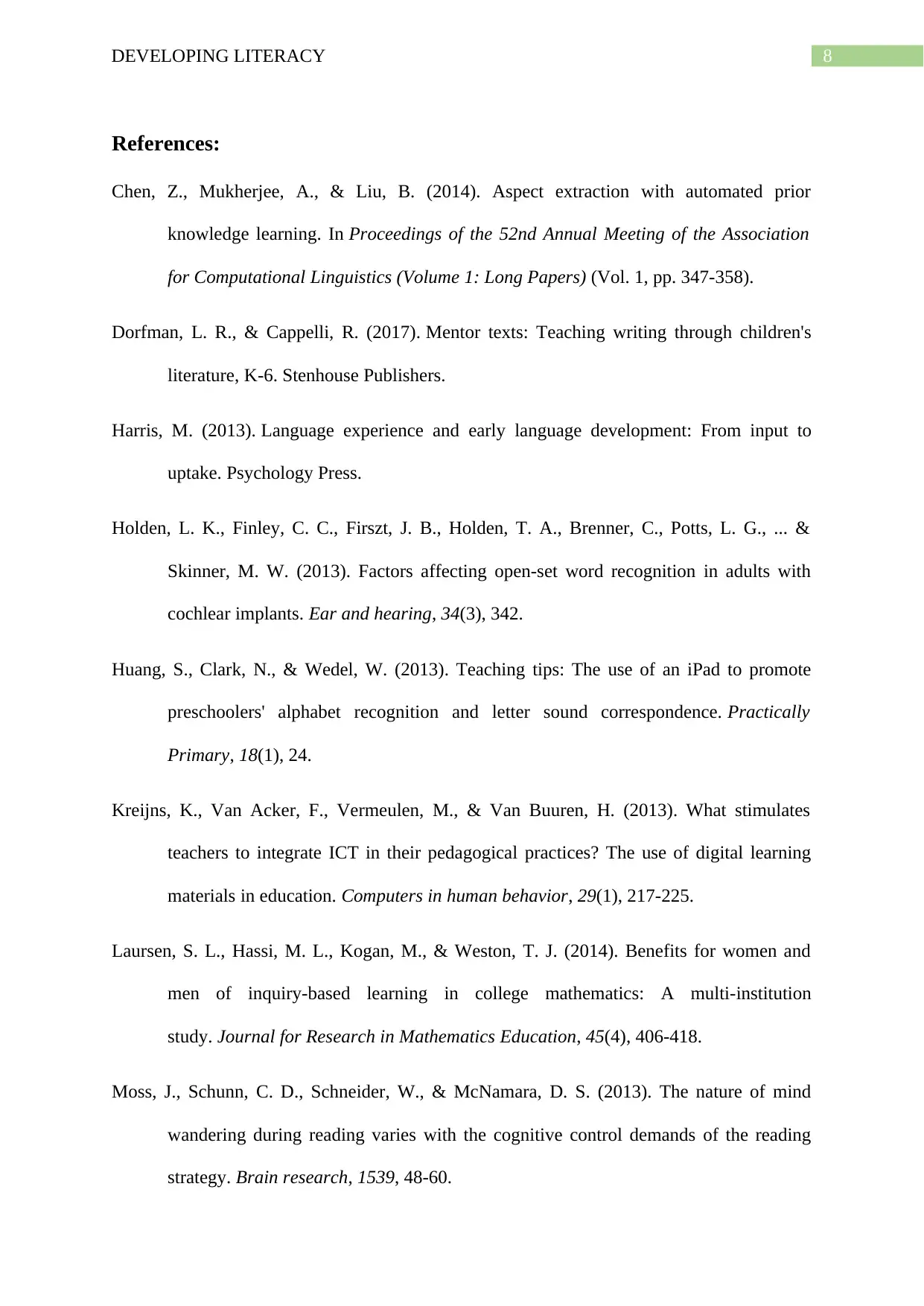
8DEVELOPING LITERACY
References:
Chen, Z., Mukherjee, A., & Liu, B. (2014). Aspect extraction with automated prior
knowledge learning. In Proceedings of the 52nd Annual Meeting of the Association
for Computational Linguistics (Volume 1: Long Papers) (Vol. 1, pp. 347-358).
Dorfman, L. R., & Cappelli, R. (2017). Mentor texts: Teaching writing through children's
literature, K-6. Stenhouse Publishers.
Harris, M. (2013). Language experience and early language development: From input to
uptake. Psychology Press.
Holden, L. K., Finley, C. C., Firszt, J. B., Holden, T. A., Brenner, C., Potts, L. G., ... &
Skinner, M. W. (2013). Factors affecting open-set word recognition in adults with
cochlear implants. Ear and hearing, 34(3), 342.
Huang, S., Clark, N., & Wedel, W. (2013). Teaching tips: The use of an iPad to promote
preschoolers' alphabet recognition and letter sound correspondence. Practically
Primary, 18(1), 24.
Kreijns, K., Van Acker, F., Vermeulen, M., & Van Buuren, H. (2013). What stimulates
teachers to integrate ICT in their pedagogical practices? The use of digital learning
materials in education. Computers in human behavior, 29(1), 217-225.
Laursen, S. L., Hassi, M. L., Kogan, M., & Weston, T. J. (2014). Benefits for women and
men of inquiry-based learning in college mathematics: A multi-institution
study. Journal for Research in Mathematics Education, 45(4), 406-418.
Moss, J., Schunn, C. D., Schneider, W., & McNamara, D. S. (2013). The nature of mind
wandering during reading varies with the cognitive control demands of the reading
strategy. Brain research, 1539, 48-60.
References:
Chen, Z., Mukherjee, A., & Liu, B. (2014). Aspect extraction with automated prior
knowledge learning. In Proceedings of the 52nd Annual Meeting of the Association
for Computational Linguistics (Volume 1: Long Papers) (Vol. 1, pp. 347-358).
Dorfman, L. R., & Cappelli, R. (2017). Mentor texts: Teaching writing through children's
literature, K-6. Stenhouse Publishers.
Harris, M. (2013). Language experience and early language development: From input to
uptake. Psychology Press.
Holden, L. K., Finley, C. C., Firszt, J. B., Holden, T. A., Brenner, C., Potts, L. G., ... &
Skinner, M. W. (2013). Factors affecting open-set word recognition in adults with
cochlear implants. Ear and hearing, 34(3), 342.
Huang, S., Clark, N., & Wedel, W. (2013). Teaching tips: The use of an iPad to promote
preschoolers' alphabet recognition and letter sound correspondence. Practically
Primary, 18(1), 24.
Kreijns, K., Van Acker, F., Vermeulen, M., & Van Buuren, H. (2013). What stimulates
teachers to integrate ICT in their pedagogical practices? The use of digital learning
materials in education. Computers in human behavior, 29(1), 217-225.
Laursen, S. L., Hassi, M. L., Kogan, M., & Weston, T. J. (2014). Benefits for women and
men of inquiry-based learning in college mathematics: A multi-institution
study. Journal for Research in Mathematics Education, 45(4), 406-418.
Moss, J., Schunn, C. D., Schneider, W., & McNamara, D. S. (2013). The nature of mind
wandering during reading varies with the cognitive control demands of the reading
strategy. Brain research, 1539, 48-60.
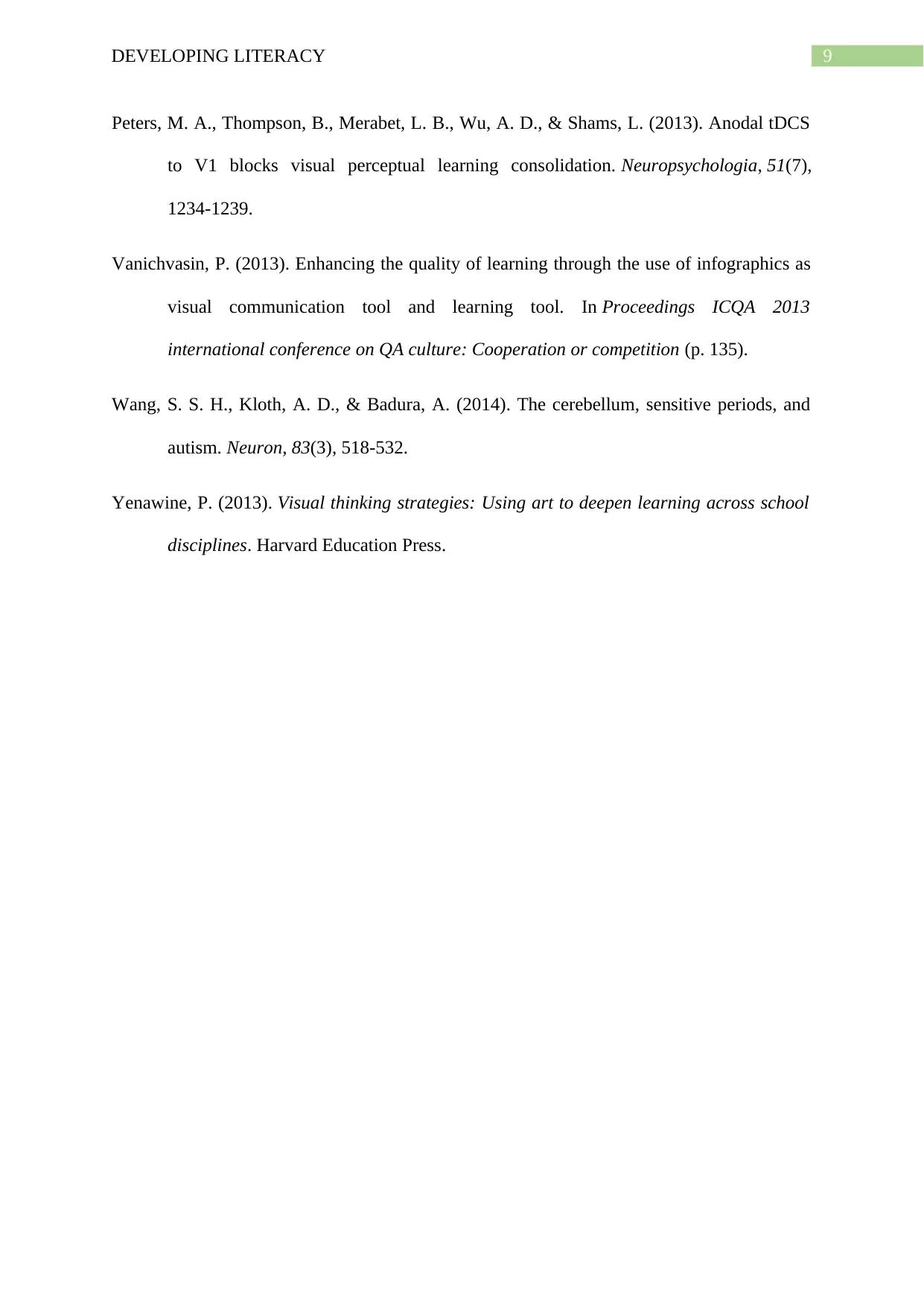
9DEVELOPING LITERACY
Peters, M. A., Thompson, B., Merabet, L. B., Wu, A. D., & Shams, L. (2013). Anodal tDCS
to V1 blocks visual perceptual learning consolidation. Neuropsychologia, 51(7),
1234-1239.
Vanichvasin, P. (2013). Enhancing the quality of learning through the use of infographics as
visual communication tool and learning tool. In Proceedings ICQA 2013
international conference on QA culture: Cooperation or competition (p. 135).
Wang, S. S. H., Kloth, A. D., & Badura, A. (2014). The cerebellum, sensitive periods, and
autism. Neuron, 83(3), 518-532.
Yenawine, P. (2013). Visual thinking strategies: Using art to deepen learning across school
disciplines. Harvard Education Press.
Peters, M. A., Thompson, B., Merabet, L. B., Wu, A. D., & Shams, L. (2013). Anodal tDCS
to V1 blocks visual perceptual learning consolidation. Neuropsychologia, 51(7),
1234-1239.
Vanichvasin, P. (2013). Enhancing the quality of learning through the use of infographics as
visual communication tool and learning tool. In Proceedings ICQA 2013
international conference on QA culture: Cooperation or competition (p. 135).
Wang, S. S. H., Kloth, A. D., & Badura, A. (2014). The cerebellum, sensitive periods, and
autism. Neuron, 83(3), 518-532.
Yenawine, P. (2013). Visual thinking strategies: Using art to deepen learning across school
disciplines. Harvard Education Press.
1 out of 10
Related Documents
Your All-in-One AI-Powered Toolkit for Academic Success.
+13062052269
info@desklib.com
Available 24*7 on WhatsApp / Email
![[object Object]](/_next/static/media/star-bottom.7253800d.svg)
Unlock your academic potential
© 2024 | Zucol Services PVT LTD | All rights reserved.





